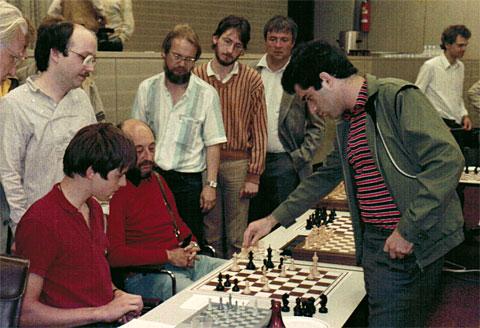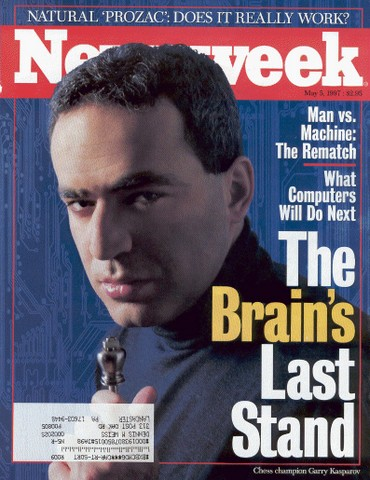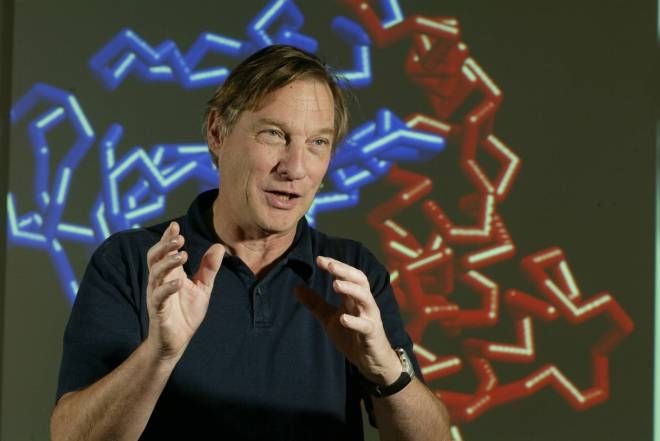
🧬 From games to science breakthrough - the story of AlphaFold
The history of computers competing against humans is long, and often attracts enormous attention. But what is it good for? What does it matter if a computer can win in chess, Go, or Starcraft? We got the answer when AlphaFold solved a 50-year old grand challenge in biology.
Share this story!
In 1985, a young, cocky chess grandmaster named Garry Kasparov played thirty-two games simultaneously. Not against other people, but computers. He won all of them quickly, except one. One computer put up a fight and Kasparov had to sharpen his concentration. He tricked the computer by sacrificing a pawn, and won.
Total score Kasparov 32 - Computers 0.

Kasparov versus Deep Blue
Eleven years later Kasparov again played against a computer. This time only one, called Deep Blue. A considerably more powerful machine than the ones he had encountered earlier, it was able to calculate 100 million possible moves per second. Something no human brain can come close to. Not even Garry Kasparov's.
In the first game, the computer shocked Kasparov by sacrificing a pawn, a similar move to his own in 1985.
"It was a wonderful and extremely human move. … I could feel--I could smell--a new kind of intelligence across the table."
This was a first glimpse of what to come. Computers weren't only calculating machines, they started to think.
IBM's Deep Blue won that game, but lost the match 4-2.
Kasparov played versus an upgraded Deep Blue again the next year, and by then the machine could calculate 200 million moves per second. It showed, and the match was tied 2 ½ - 2 ½. If the computer had won the last game, it would have been the first time a computer had beaten a chess world champion.
In the deciding game the score was even when the computer sprung a trap and sacrificed a rook. Kasparov took the bait, which lead to him losing 20 moves later.
Total score Kasparov 2 ½ - Deep Blue 3 ½.

Next challenge: Go
Chess is complicated for a computer to win, because you can't just calculate all possible moves. You must think ahead and, like the computer learned, sometimes take short-term losses for long-term gains.
But even more complicated for a computer is another board game, Go.
It's played on a board with 19 x 19 squares. Like chess, you have black and white pieces, called stones. If the other player's stones surround a stone, it is removed from the board. The goal is to control a larger area than your opponent.
It is more complicated for a computer since there are so many more alternatives. In chess there are 20 possible opening moves. In Go the first player has 361 possible moves. Just brute-forcing isn't the solution, and good players often describe that they almost feel what the right move is.
"I'll see a move and am sure it's the right one, but won't be able to tell you exactly how I know. I just see it," - Go player, Michael Redmond says.
Winning over human grandmasters in Go was the next challenge for the computer. Now called AlphaGo, developed by the company DeepMind, owned by Alphabet.
The game versus world champion Lee Sedol is beautifully captured in the documentary AlphaGo.
Since the programmers couldn't teach the computer all the possible moves, in order for the computer to be able to calculate all of them, they had to teach it to learn. Using machine learning they fed AlphaGo with 30 million Go matches, and it also played another 30 million matches against itself.
AlphaGo easily won, 4-1, versus the slightly shocked 9-dan ranked Lee Sedol.
Playing games is fun, but what real use is it?
These weren't the only computer versus human competitions. IBM created Watson to play Jeopardy and DeepMind created AlphaStar to play Starcraft. Fun, but what is the real purpose?
We got an answer to that question when AlphaFold solved a 50-year-old grand challenge in biology.
Actually, this was another competition.
In 1972, in his acceptance speech for the 1972 Nobel Prize in Chemistry, Christian Anfinsen, said that it should be possible to fully determine a protein's structure by its amino acid sequence.
The problem is to figure out how a protein chain folds when it takes its three-dimensional structure. Brute force calculations are not possible, since the numbers are astronomically big.
To speed up progress, professor John Moult and professor Krzysztof Fidelis founded CASP. In this biannual competition, teams predict the fold of a protein that has been experimentally determined but not yet published.
DeepMind entered the competition with AlphaFold in 2018 and immediately won. But they didn't get very close to the score of 90, which is considered competitive with results obtained from experimental methods.
So DeepMind entered this year's competition as well, and this time they didn't just win, they blew everyone out of the water, with a median score of 92.4.
"We trained this system on publicly available data consisting of ~170,000 protein structures from the protein data bank together with large databases containing protein sequences of unknown structure."
The same way they learned AlphaGo to play Go and AlphaStar to play Starcraft.
A science breakthrough
This is a breakthrough and the science world was jubilant.
"This computational work represents a stunning advance on the protein-folding problem, a 50-year-old grand challenge in biology. It has occurred decades before many people in the field would have predicted."
Professor Venki Ramakrishnan, Nobel Laureate and President of the Royal Society
Nearly every function that our body performs relies on proteins, and how they move and change. What any given protein can do depends on its unique 3D structure. Having a fast and not-so-expensive way to understand that structure has enormous potential.

John Moult explains:
"Even tiny rearrangements of these vital molecules can have catastrophic effects on our health, so one of the most efficient ways to understand disease and find new treatments is to study the proteins involved."
"There are tens of thousands of human proteins and many billions in other species, including bacteria and viruses, but working out the shape of just one requires expensive equipment and can take years."
But now it can be done in days, hours and minutes instead.
I'll let John Moult end this text on this optimistic note.
"This gives you such excitement about how science works. That you never can see exactly, or even approximately, what's going to happen next. There are always these surprises. And that really, as a scientist, is what keeps you going. What is going to be the next surprise?"
By becoming a premium supporter, you help in the creation and sharing of fact-based optimistic news all over the world.


